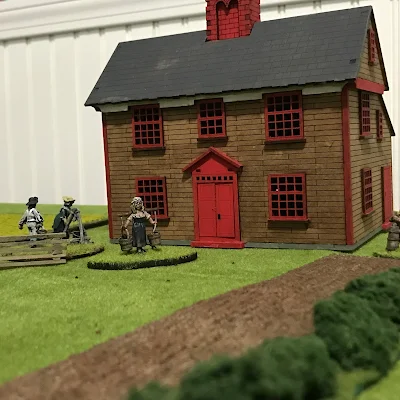After initially posting this regiment I had not awarded them set of colors. My rational was loyalist regiments this early in the war probably did not have them. Also, with such a hard luck history did they deserve them? Or would they just lose them in battle? But I did post the question here and on the Fife and Drum forum should they get colors? The answer overwhelmingly was yes they should.
In their first action on the table top the regiment broke the long time tradition of new regiments mucking it up and instead did very well. They advanced, took casualties and passed morale checks. Almost as if they were saying, "yes, we deserve colors!"
But which colors to give them and what would they look like? Dave from "Not By Appointment" website ( https://nba-sywtemplates.blogspot.com/2022/08/speculative-but-plausible-flags-for.html). came to my rescue. He designs flags for the Seven Years War , but used his vast knowledge of vexillology to come up with a plausible looking flag. I think it looks outstanding and not out of place in the Rev War period. I think it also reflects the grandiose ideas Colonel Browne had for his Regiment and himself.
Because I do not have a printer my friend AJ ( http://ajs-wargaming.blogspot.com) did this for me. The templet worked and after sizing it to fit in with my other colors he sent me two sets. Warren was kind enough to drop it off at the hoyse after getting it from AJ. Then it was just cut it out and glue to the pole. In not time the Prince of Wales America Regiment had its new set of colors. Magnificent!
Then it was staging a review and award ceremony with Lord Cornwallis.
A gigantic and heartfelt "Thank You" to Dave for the flag design and templet, AJ for printing it for me and Warren for getting it from AJ to me. Thank you guys very much! You are the best. And three cheers and a tiger for the PoWAR regiment and their brand new colors. Well done lads!
























.jpeg)


.jpeg)






















